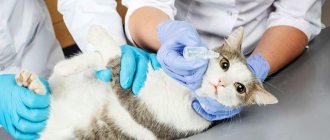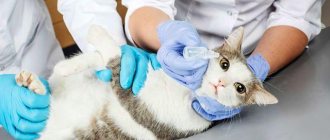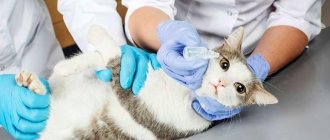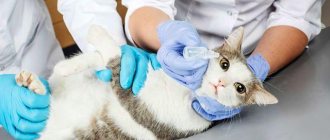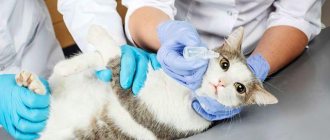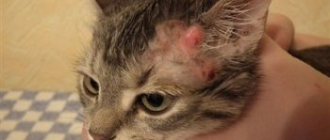By bringing a small fluffy kitten into our home, we take responsibility for its health. In addition to proper feeding, vaccinations, and grooming, ear cleaning should become a regular procedure. This is necessary in order to prevent ear diseases, which cause suffering in pets and take a long time to treat. Questions about how to clean a kitten’s ears, whether it is necessary to do this if the ear is clean, arise often. It all depends on the pet’s lifestyle, the breed, and even the size of the ears.
How often to clean your ears
Whether a cat’s ears need to be cleaned can only be determined after a careful examination. It is advisable to do it daily. You should make it a rule that when your pet sits comfortably on your lap, look into its ears. If there are no dark deposits, stains, dots or scratches, no cleaning is required. Clean ears that do not bother the cat can be cleaned once every few months as a preventive measure.
Your cat's ears need to be cleaned if:
- dirt, dusty deposits;
- spots, dots or bumps that are black or brown;
- dry dark crusts;
- excess sulfur, purulent discharge;
- scratches, dried blood;
- unpleasant odor from the ear canal.
It is also necessary to cleanse if the cat shakes its head and constantly scratches its head behind the ears.
Ears should be examined daily and cleaned as soon as they become dirty.
Signs you need cleaning
You can understand that your pet needs ear cleaning after an examination. To do this, the ear is carefully turned inside out and examined.
It should be borne in mind that the cat may not like this, so you need to accustom him to the procedure from a young age.
If there is a lot of dirt in your ears, then you just need to clean them. But in some cases it is better not to self-medicate, but to immediately contact a veterinarian:
- Black plaque. It may indicate infection with ear mites, and may also be a sign of otitis media or other serious diseases. If left untreated, there is a high risk of deafness. After diagnosis, the doctor will prescribe ear drops depending on the form. Treatment must be carried out every day.
- Atypical formations. Consultation is necessary to determine the diagnosis. Most often, the course of treatment lasts from 15 to 20 days, then a re-examination by a specialist is required.
Other indications for ear cleaning:
- Large amount of sulfur. Ear cleaning is carried out as it accumulates, the frequency depends on the individual characteristics of the cat and breed.
- Exhibition. When attending various competitions, the cat must be clean, as the judges pay attention to such moments.
- Lack of wool. There is a risk of proliferation of pathogenic microflora, since there is no natural barrier protecting against dirt. Typical for hairless cats.
- After swimming. Remove residual moisture from the ear, this helps prevent the development of otitis media.
What you need to clean your ears
Many cats do not like the cleansing procedure; they may break out, scratch, hiss, and even bite. It is best to teach it from an early age, as cleaning a kitten’s ears is not difficult. A kitten whose ears have been cleaned since childhood, slowly and without sudden movements, has no fear of such a procedure. Some pets even like it, they close their eyes and lie quietly.
For stubborn adult animals, it is best to wrap them in a large towel or thin blanket. It is important that the cat does not have the opportunity to pull out its paws. This way you will not only make cleaning easy, but also protect yourself from deep scratches.
What you need for cleaning:
- cotton pads (sponges), they can be replaced with soft cotton cloth;
- cotton buds;
- a special lotion or gel for cleaning, which can be purchased at a veterinary pharmacy.
Since cleaning a cat’s ears at home sometimes needs to be done urgently, a special lotion can be replaced with vegetable oil or warm boiled water.
You should know that any cleanser is applied to a cotton pad. Under no circumstances should you drip it into a cat's ears.
Types of pathogenic staphylococci
Several types of bacteria are dangerous to humans. The most common:
- Staphylococcus aureus: golden. It got its name because of the characteristic yellow pigment on the surface. Penetrating into the body, it synthesizes the enzyme coagulase and can cause purulent inflammation of almost any internal organs. This type of pathogen quickly adapts to the effects of antibiotics, forming resistant forms.
- Staphylococcus epidermidis: epidermal. It usually affects the skin and mucous membranes. It often becomes a factor in inflammation of injuries, postoperative sutures, the development of purulent conjunctivitis, and respiratory tract infections.
- Staphylococcus saprophyticus: saprophytic. Its specificity: affects the mucous membranes of the urinary organs, provokes cystitis, urethritis, and kidney inflammation.
- Staphylococcus haemolyticus: hemolytic. Dangerous for mucous membranes and tissues of internal organs. It becomes a provocateur of the development of endocarditis, pneumonia, nephritis and other severe pathologies.
Almost all types of pathogenic staphylococci are prone to mutations as a result of improper or insufficiently long treatment.
Rules for cleaning ears
To carry out hygiene measures you do not have to run after your pet throughout the house, pull it out from under the bed or remove it from the closet, before the procedure you should play with it a little or caress it. Everything you need must be prepared in advance. In order to calm a cat, it is enough to stroke it and talk in a calm, quiet voice. Prepare your favorite treat. A small piece can be given in advance.
How to properly clean your ears:
- wrap your pet in a thin blanket;
- Gently bend the ear outward so that all the curves of the inner part become visible. It doesn't hurt cats;
- soak a cotton pad or soft cloth in the cleanser and lightly wipe the entire inside of the ear;
- if there is a lot of dirt, then you should take a clean disk and repeat the cleansing;
- The cotton swab should also be moistened and all bends should be thoroughly cleaned. If necessary, the procedure should be repeated.
It is a myth that a pet's eardrum can burst. In cats, there is a bend in the ear, and it is impossible to reach the eardrum with a stick. The only thing that can cause harm is scratching the thin skin if the stick is very hard or if you clean it carelessly.
It is important to carry out all cleaning movements from the inside out, otherwise you can push dirt inside the ear canal, which can cause an inflammatory disease.
What you need to prepare before the procedure
- Clean cotton pads, swabs, or small soft wipes.
- Cosmetic and hygienic lotion for cleaning the ears.
Do not use shampoos, soap solutions or other liquids. They can harm your pet's health.
You should also not use hygienic sticks or matches wrapped in cotton wool for three reasons:
- The animal may jerk its head during the procedure, which carries the risk of damage to the ear canal.
- During the cleaning process, the cotton part may remain in the ear, which is dangerous for the pet.
- There is a risk of scratching the inside of the ear with a hard object, which can cause infection.
When dirt in the ears is an indicator of disease
Sometimes dirty ears are an indicator of a disease. Contacting a veterinary clinic may be required if:
- ears get dirty within a few days after hygiene procedures;
- a lot of wax is produced in the ear canal;
- purulent discharge does not stop;
- At the same time, the cat is restless, itches often, leaving scratches, and shakes its head.
Such symptoms occur with otitis media of any severity or when the ear canal is damaged by ear mites. Accurate diagnosis is carried out in a veterinary clinic. The earlier treatment is started, the more effective it is, and the less the animal suffers.
If left untreated, your pet may experience deafness. In addition, the ear contains the vestibular apparatus, which is responsible for balance. If your cat has ear diseases, he or she may experience dizziness and nausea.
Drops are used to treat ear diseases. In some cases, the veterinarian may prescribe antibacterial and anti-inflammatory drugs.
It is necessary to instill the medicine only after removing purulent discharge and sulfur, otherwise the effect of the drug will not be effective. The cleansing procedure is carried out in the same way as for healthy cats, but instead of a special cleansing gel, the doctor may recommend hydrogen peroxide or chlorhexidine. After recovery, they should not be used. They cause the delicate skin on the inside of the ears to dry out and peel. For the same reason, you should not use products containing alcohol.
What to look for
Too much secretion in the ear canal forms a breeding ground for the development of pathogenic microflora. In more advanced cases, sulfur plugs may appear, which entail pressure on the eardrum, hearing problems and the functioning of the vestibular apparatus. This may manifest itself as an unsteady gait, a head tilted to the side, and other symptoms.
Remember: if your cat begins to shake its head, scratch its ears, or otherwise become restless, and you find discharge, black plaque, brown spots, or redness inside the ear, these may be signs of diseases that threaten your pet’s health.
In this case, you need to urgently show the animal to a veterinarian. He will examine the ears and prescribe appropriate treatments, procedures, or the use of specific medications.
Who suffers from ear problems most often?
Ear mites are transmitted from other animals through close contact. Most often, it affects cats that are often outdoors, living in nurseries or shelters. When bringing a new pet into your home, it should be quarantined for a while. This can protect other cats not only from tick infection, but also from other serious diseases.
Otitis media occurs when hygiene standards are not followed, when the pet is kept in a cool room or in a draft.
When bathing your pet, you need to protect its ears from water getting into them. After water procedures, you should immediately clean your cats ears with a dry soft cloth.
Kittens, old cats, or weakened animals suffer the most. In addition, some breeds of cats that have large ears or lack fur are susceptible to ear diseases. These are the Sphynx, Devon Rex, Maine Coon, Somali, Abyssinian and Oriental cats.
Prevention of ear diseases in cats
Prevention of diseases accompanied by pathological discharge from the pet’s ears includes the following list of measures.
- Maintaining hygiene of the animal's external auditory canal.
- Protecting your pet's ears from injury, mechanical damage, water, foreign objects and other negative influences.
- Regular examination of the auricle to detect redness, crusts, scratches, seals, areas of inflammation, etc.
- Regular disinfection of cat housing, care items, and toys.
- Suppression of contacts with homeless relatives.
- Timely antiparasitic treatment of all pets living in the house.
The last point is especially important! Antiparasitic treatment of pets is carried out regardless of access to the street. After all, ticks can enter the apartment on the owner’s shoes or clothes. Stronghold drops on the withers will provide reliable protection against them. After applying them for a month, even during a walk, your cat will not be afraid of ear parasites.
Allowed self-medication
The pathological condition of the ear canal causes discomfort in the patient, so many try to be treated at home. Incorrect treatment will not help get rid of the problem, but can cause additional negative effects. When using cotton swabs, toothpicks, matches and other long thin objects, serious complications can develop. The secretion of the sulfur glands does not come out, but is pushed even deeper. As a result, the problem worsens and unpleasant symptoms intensify.
If there is no fever or pain, you can try to get rid of the plug without visiting the hospital. To dissolve it, medicinal drops and pharmaceutical solutions are used. “A-Cerumen” or “Remo-vax”, 3% hydrogen peroxide are popular remedies that can help in this situation. They should be used strictly according to the instructions. Pharmacists can offer herbal suppositories or herbal funnels, however, these drugs can aggravate the process and their use is not recommended.
Deeply soiled cleaning
You can clean deep dirt as follows:
- The kitten is fixed in a comfortable position.
- A special product is instilled into the ear.
- The ear is gently massaged in the lower part - this way the drug is distributed evenly throughout the entire inner part.
- The animal is released so that the pet can shake its head.
- The kitten is picked up again, the cotton swab is immersed deeper, removing dirt
- Additionally, cleaning is carried out using a cotton pad.
- Similar manipulations are performed with the second ear.
Owner reviews
There are special lotions for cleaning ears. If another method is not indicated in the instructions: place a few drops on the sink, fold the ear in half, massage, then wipe the sink with a cotton pad moistened with lotions. If the ears are very dirty (dirt is not only on the shell, but also deeper) - then use a cotton swab. It’s better (more convenient) to use tweezers (not sharp) wrapped in cotton wool (they don’t bend). If you have mites, you can drip hydrogen peroxide instead of lotion (preferably slightly diluted with water), it will foam in the ear. Massage. Clean the ear with a swab and cotton pad. Then apply anti-tick drops.
Not invented
https://www.e1.ru/talk/forum/read.php?f=130&i=485451&t=485451&
We just swaddled ours stupidly and put peroxide in, you definitely shouldn’t pick anything in your ears yourself, this should be done by a veterinarian, with a special tool, you can damage the eardrum because they can twitch at any moment, there is no control over the animal... in fact. And to euthanize for such a procedure, that stupidity, any anesthesia or sleeping pills will hit any animal hard in the heart, and it may not recover.
Egorushka
https://dasinok.ru/forum/thread551.html
If it’s just superficial, that is, from wax or dirt, then there’s nothing wrong with it at all, just swaddling, and dip a cotton ball in vegetable oil, or better yet, buy a special ear cleaning gel, and wipe the inside of the ears with it, and after about a minute five ten, very carefully clean the folds in your ear with a cotton swab, the main thing is not to go deep, as you can very easily damage the eardrums, but if something gets in, or a tick suddenly starts up, then at home, it’s better not to mess with it, go straight to veterinarian, they can easily get rid of ticks and foreign bodies, as they use special retractors.
Kiskin
https://dasinok.ru/forum/thread551.html l
During my school years I had a kitten with ear mites. This infection multiplies very quickly and is very difficult to remove. And he combed his ears to holes. Constantly shook his head and almost bricks flew out of his ears………. I took it out for half a year. It crawled into my ear almost to my brain. And he endured, calmly endured this torture because he felt that it would become easier later. I cleaned it clean, treated it with an anti-tick solution, and after 2-3 days the inside of the ear was again invisible - just blackness...... In my opinion, it didn’t completely remove it... Besides, it’s contagious. I was then treated myself because the kitten slept with me. …….
alina
https://www.thaicat.ru/forum/7–227–1
It's better to clean with two people. One holds it in his arms, it is possible without a towel. And ear sticks for children. Very good Otoferonol is a good remedy for ticks and inflammation. Right now we are cleaning a 3-month-old kitten. The first time I wanted to break free, but the third time I just made my eyes look miserable and looked so miserable. Just say, that's all. And immediately the cheerful one becomes a cunning one. The doctor prescribed Otoferonol, do everything according to the instructions.
Alla
https://www.woman.ru/home/animal/thread/4093303/
Sphinx, there is no need to clean the deep ears of cats with chopsticks at all, neither healthy ones, nor especially an animal with otitis media. Usually, in this case, the signs of inflammation become even more pronounced (as the surface of the ear canal is injured when picking). We need to figure out the causes of otitis - maybe there is an ear mite, a bacterial or fungal infection, or something else. Depending on the reason, choose a medicinal product for treatment. It is necessary to clean the ears, but by gentle rinsing/softening (ask your veterinarian at your appointment to show you how to do this...although some still recommend cleaning with chopsticks). PS, deep cleaning of the ears with chopsticks during otitis media is also very painful.
VetMD
https://mauforum.ru/viewtopic.php?p=1615626
take Bars drops (sold at a veterinary pharmacy), cotton swabs, a blanket (towel, scarf, etc.). You swaddle the cat so that it doesn’t break out, dip a cotton swab in the drops and carefully run it along the folds from the depths to the outside. Change the stick after each fold! Just don’t stick it deep into the ear, the cat will have problems with hearing later.
Nightmare on an empty stomach
https://deti.mail.ru/forum/dosug/bratja_nashi_menshie/pomoch_kotu/
